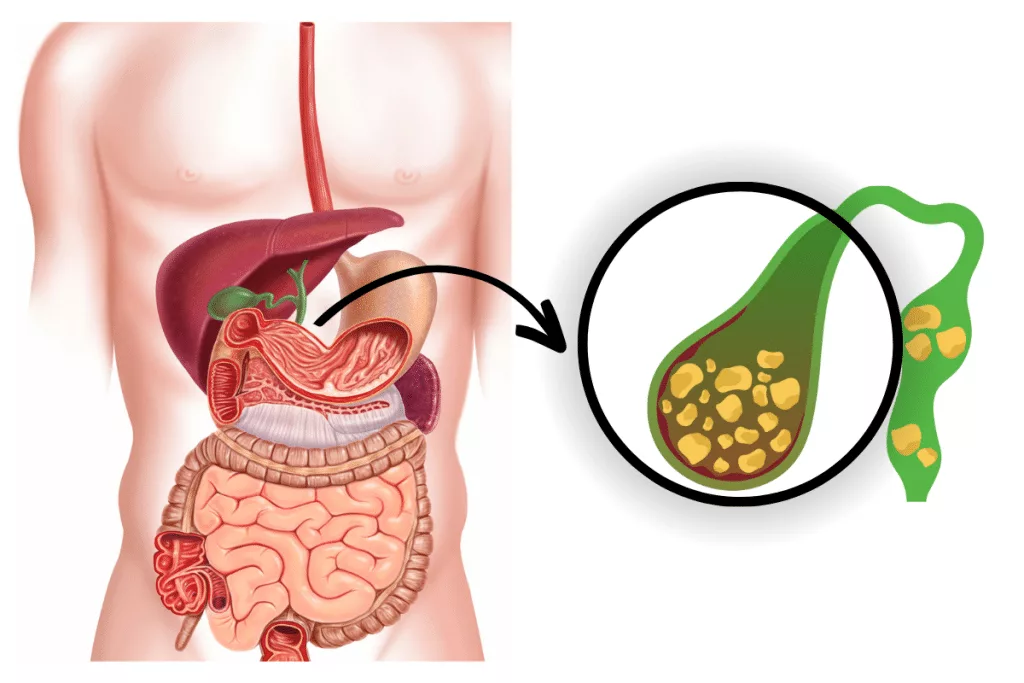
Gallstones are hard, pebble-like substances that form in the gallbladder, a small organ located under the liver. The gallbladder stores bile, a fluid that helps digest fats. Gallstones form when there’s an imbalance in the substances that make up bile, like cholesterol or bilirubin.
Types of Gallstones
- Cholesterol Gallstones
- Most common (80%)
- Yellow-green in color
- Made mostly of hardened cholesterol
- Pigment Gallstones
- Smaller and darker
- Made of excess bilirubin
- More common in people with liver disease or certain infections
🔹 Causes and Risk Factors
- High cholesterol in bile
- Poor gallbladder emptying
- Too much bilirubin (from liver disease or hemolysis)
- Risk factors:
- Female (especially with estrogen exposure)
- Age > 40
- Pregnancy
- Obesity
- Rapid weight loss
- Diabetes
- Family history
- Diet high in fat and low in fiber
🔹 Symptoms
Many people have “silent” gallstones (no symptoms). When symptoms occur, it’s called gallstone disease or cholelithiasis.
Common Symptoms:
- Sudden, intense pain in the upper right or middle abdomen
- Pain after eating, especially fatty meals
- Pain radiating to right shoulder or back
- Nausea or vomiting
- Indigestion, bloating
Serious Signs (May Indicate Complications):
- Fever and chills (suggests infection)
- Jaundice (yellowing of skin/eyes)
- Persistent vomiting
- Light-colored stools, dark urine
🔹 Complications
- Cholecystitis: Inflammation of the gallbladder
- Choledocholithiasis: Stones in the bile duct
- Pancreatitis: Inflammation of the pancreas
- Gallbladder cancer (rare)
🔹 Diagnosis
- Ultrasound: Most common and effective
- CT scan or MRI
- HIDA scan: Checks gallbladder function
- Blood tests: Look for signs of infection, liver function, or blocked bile ducts
🔹 Treatment Options
🏠 If Asymptomatic
- No treatment needed (watchful waiting)
💊 Non-surgical Treatments
- Oral bile acid pills (e.g., ursodiol) – slow-acting, for people who can’t have surgery
- Dissolution by contact solvents – rarely used
- Dietary changes – reduce fat intake
🩺 Surgical Treatment (Standard of Care)
- Cholecystectomy (gallbladder removal)
- Laparoscopic (minimally invasive) – most common
- Open surgery – for complicated cases
- Life is normal without a gallbladder; bile flows directly into the intestine
🔹 Post-surgery Advice
- Avoid fatty meals initially
- Small, frequent meals
- Gradual return to normal activity
- Watch for signs of infection after surgery
🔹 Prevention Tips
- Maintain a healthy weight
- Avoid rapid weight loss
- Eat a balanced diet with fiber
- Limit cholesterol and saturated fats
- Exercise regularly
❗️When to See a Doctor
- Recurrent abdominal pain
- Nausea or vomiting after meals
- Signs of infection or jaundice
- Family history of gallstones or complications



